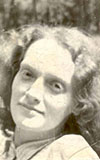

In 1945 she enrolled at the Budapest Academy of Fine Art, and as indicated by her records, she studied anatomy and perspective from Jenő Barcsay. In 1946 she married and left the Academy, but went on creating works on paper. Between 1945 and 1949, she created a number of series (self-portraits, self-portraits in pregnancy, landscapes of Szentendre, Ganz factory series, portraits of the family members, the table series). During the 1990's collections of her drawings were acquired by the British Museum, the Museum Kunst Palast of Düsseldorf and the Israel Museum and in 2003 also by the National Gallery of Hungary.
In 1949, partly under the pressure of communist dictatorship and partly based on her own autonomous decision, she gave up creating art, but as she wrote on the invitation card of her 1965 studio exhibition, "this standstill did not mean that my love for art had gone." As shown by 150 of notebooks preserved in her estate, she pursued extensive studies of art history and colour theory.
From 1967 on, in her second artistic period, which was largely influenced by her 1969-1970 stay in Paris, she mainly created oil paintings that can also be grouped into series (artificial flower series, rose garden series, portraits of friends and relatives and self-portraits from the last years of her life). The artist wrote down her colour speculations connected with the creation of the paintings in diaries. Although Ilka Gedő's paintings reveal unique, poetic and spectacular colours, F. István Mészáros points out that "the artist covers a word already fallen to pieces with her nostalgically painful veil of colours, in which the contrasts between dark and warm colours always strive for some nameless anxiety." László Beke, in a letter dated 10 August 1980 that is preserved in the artist's estate, notes: "I think it would be utterly pointless to compare your painting with the «contemporary» trends. As far as the essence of these works is concerned, they could have been born at any time between 1860 and 2000. They are not inspired from the «outside», but from the «inside», thus their coherence and authenticity derive from the relationship that these works have with their creator. No viewer of these works can fail to notice this.”
One-woman exhibitions: Studio Exhibition (1965); King St. Stephen's Museum, Székesfehérvár, Hungary (1980); Dorottya Utca Galllery, Budapest (1982); Artists' Colony Gallery, Szentendre, Hungary (1985); Palace of Exhibitions, Budapest (1987); Gallery of Szombathely (1989); Hungarian Jewish Museum, Budapest, [with György Román] (1995); Budapest Municipal Picture Gallery, Museum Kiscell (2001); Raiffeisen Gallery (2003-2004); Hungarian National Gallery (2004-2005). One-woman exhibitions abroad: Compass Gallery, Glasgow (1985); Third Eye Centre, Glasgow (1989); Janos Gat Gallery, New York (1994 and 1997); Yad Vashem Art Museum [with György Román] 1996, Shepherd Gallery, New York (1995).
Website: The Complete Works of Ilka Gedő http://www.ilkagedo.hu
